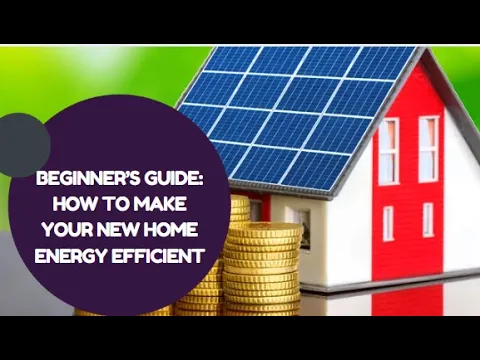Beginner’s Guide: How To Make Your New Home Energy Efficient
Want to pack or move your belongings like professionals? Read our blog posts that will help you manage relocation process with ease.

Want to pack or move your belongings like professionals? Read our blog posts that will help you manage relocation process with ease.


When moving into a new home, most people focus on decor, unpacking or buying new furniture. But one of the smartest things you can do early on is to think about energy efficiency. Making your home energy efficient not only lowers your electricity bills but also reduces your impact on the environment.
This blog covers simple, practical steps to help you turn your new home into a cost effective, eco friendly home. Whether you have just moved in with help from expert removalists Perth or planning to relocate soon, making smart energy choices from the beginning is a great investment. These changes do not have to be expensive or complicated; even small steps can make a big difference over time.
Before making any upgrades or purchases, you should first evaluate where your house ranks in terms of energy efficiency. An energy audit is the most effective way to identify problem areas including air leaks, poor insulation, obsolete equipment, and inefficient lighting.
You can hire a professional auditor or do a basic DIY version. Walk through your home with a checklist, paying close attention to drafts near windows and doors, the age of your appliances and how well your heating or cooling system is performing. This initial step gives you a clear plan of action for improvements that will have the most impact.
Even minor cracks near windows, doors, and vents can allow hot or cold air to enter, making your heating and cooling systems work harder. Begin with closing holes and blocking unwanted airflow using weatherstripping, caulking or door sweeps.
Then, check the insulation in your walls, flooring, and ceiling. A well insulated home can keep you warm during winter and cool during summer, reducing the use of energy hungry appliances. If you’re a new resident, checking these areas before you settle in means you can make adjustments promptly and effectively.

Lighting may seem like an insignificant issue, but it can account for up to 10-15% of your house’s energy consumption. Replacing typical incandescent bulbs with LED equivalents yields immediate results. LEDs last significantly longer and use a fraction of the energy, which saves you money over time.
Concentrate initially on the most frequently used rooms: the living room, kitchen, bathrooms and bedrooms. Consider installing dimmers, timers or motion sensors to prevent lights from staying on unnecessarily. These little tweaks can drastically cut your overall electricity use while requiring little effort.
If your present appliances are old or secondhand, they may be drawing more electricity than you know. Look for new appliances with high energy star ratings; these are designed to use less electricity and water while still delivering great performance.
For example, energy efficient washing machines use less water and finish cycles faster. Refrigerators and air conditioners with good ratings maintain optimal temperatures without draining power. If Removalists Perth helped you move bulky whitegoods, evaluate whether they are worth keeping or upgrading in the near future.
Heating and cooling typically make up the largest portion of a household’s energy use. Begin by cleaning or replacing air filters, which helps systems run more efficiently and improves indoor air quality. Dirty filters restrict airflow and force your system to work harder.
Consider adding ceiling fans in the summer to lessen the need for air conditioning, or put draft stoppers under doors in the winter to keep warm. Installing a programmable thermostat is another wise decision; it allows you to regulate temperatures for different times of day, keeping your house comfortable while preventing wasted energy when you’re away or asleep.
Smart technology can automate energy savings with very little effort. Smart thermostats, lighting and plugs allow you to control and schedule devices from your phone, so you never forget to switch something off when you’re not home.
Smart plugs can also monitor the power use of particular equipment, allowing you to discover energy hogs. Over time, this data might help you make more informed judgements about upgrades or usage trends. While the initial setup may be expensive, the long term energy savings justify it.
One of the most underutilised energy saving strategies is to just use what nature has already provided. Open the curtains during the day to naturally brighten up your house, particularly in rooms like the living room and the kitchen. This lowers the need for artificial lighting.
During the summer, keep windows open at cooler times of day, such as in the morning or evening. Cross ventilation can help to lower indoor temperature, reducing the demand for fans and air conditioners. Also, planting trees to create shade outside windows or using light coloured curtains, can help to control or minimise the heat.

Making your home energy efficient does not have to be a massive project. With some careful decisions and small changes, you can build a room that is nice, budget friendly and eco friendly. By doing things early on, you will be rewarded with long term benefits, added comfort and peace of mind knowing your home is performing as efficiently as it can.




